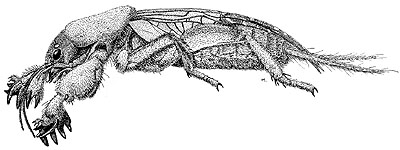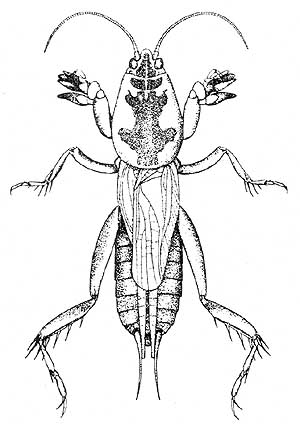
BUG OF THE MONTH: January 1997
Mole Crickets
Gryllotalpa and relatives
Order Orthoptera
Copyright © 1997 by Nel Mascall
This article originally appeared in Scarabogram, January 1997, New Series No. 201, pp. 2-3.
This summer on a visit to the Netherlands, I went to see the 'Muséon' in The Hague, a place like a whole stack of "Eyewitness" books come to three-dimensionality. Everything from Dutch waterworks to Egyptian religion to the ecology of a rain forest housed in rooms off a large central area, while the central area itself was filled with whatever did not quite fit into the rooms.

There, between fossils and Indonesian festival wear lay a stuffed mole and next to it a malevolent looking creature about 6 cm long with a smaller version of the mole's digging claws. It had antennae, short wings, and a shape like a cricket, but size, color (dark gray to black), the almost fur-like hair covering, and the digging claws made it appear more like a small mole, with dark eyes and somehow a ferocious facial expression. A "veenmol" explained my friend, and told me that they are not uncommon where she lives, a sandy, boggy area behind the dunes on the island of Voorne, southwest of Rotterdam. After hearing stories about them, she had met with one herself and even tried unsuccessfully to catch it.
 |
| Neocurtilla hexadactyla (after Hebard) |
Gryllotalpa gryllotalpa (Greek gryllos 'cricket' and Latin talpa 'mole') or "veenmol" (fen mole) is a hated presence in the vegetable gardens. Active at night, it will eat the young roots of lettuce, green onions, leeks etc. and digs around the plants, loosening the soil. In the morning a sagging row of limp plants attests to the veenmol's activities.
Excited by the idea of adding this small monster to my insect collection, and having spotted a row of limp green onions in the garden, I decided to try and catch one. On my friend's advice, I dug in some pieces of cut potato which smell would attract the veenmol. At night, armed with a flashlight, I went to inspect the potatoes several times; one or two showed the veenmol had given them a try, but not long enough for me to spot it. Apparently, once you see a veenmol your chance of catching it depends on your speed of digging and luck; I never caught one.
 |
| Scapteriscus acletus (after Blatchley) |
In a small nearby museum consisting of farm cottages full of tools, furniture and other items, the curator knew all about "veenmollen" but his own specimen had been eaten by dermestids. He furnished, however, the illustration above and some information. Gryllotalpa gryllotalpa is hemimetabolous, the wings appearing in small form in partly grown individuals, increasing to normal size in adults. Females lay about 200 eggs in a round hollow at the end of a tunnel they have dug. After hatching, the young disperse in all directions.
American mole crickets are smaller, between 21 and 30 mm long. Two common species listed in my insect key (Bland, How to Know the Insects): Neocurtilla hexadactyla, which is brown with a pointed head, front tibia with four "fingers" that curve out, eastern and midwestern North America [and via Mexico to South America]; Scapteriscus vicinus, pale brownish yellow, front tibiae with two "fingers," southeastern North America [also West Indies and South America, there called the "changa."] The second species damages crops and grasses like the Dutch veenmol.
[A few other North American species are known, including one from the Southwest, but none in our region. According to Helfer (1963), the European veenmol "is locally established at various places in the East, especially around nurseries. It makes a churring noise in its burrows." Scapteriscus also makes a sound, "described as a rich guttural 'grrr' and may be heard all about at night when one is in an infested area ... males commonly fly to lights, especially on dark cloudy nights."]
References
Blatchley, W.S. 1920. Orthoptera of North-Eastern America. The Nature Publishing Company, Indianapolis.
Hebard, Morgan. 1934. The Dermaptera and Orthoptera of Illinois. Illinois Natural History Survey Bulletin 20(3): 125-279.
Helfer, Jacques R. 1963. How to Know the Grasshoppers, Cockroaches and their Allies. William C. Brown Co.
This page last updated 26 July, 2005